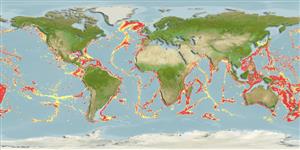Common names from other countries
>
Notacanthiformes (Halosaurs and deep-sea spiny eels) >
Halosauridae (Halosaurs)
Etymology: Aldrovandia: Taken from Ulisse Aldrovandi, (1522-1605), a Renaissance naturalist and physician noted by his systematic and accurate observations of plants and animals (Ref. 45335).
More on author: Günther.
Environment: milieu / climate zone / depth range / distribution range
Écologie
marin benthopélagique; profondeur 730 - 2560 m (Ref. 3974). Deep-water
Circumglobal, tropical to temperate. Atlantic and Indo-Pacific, except Mediterranean.
Taille / Poids / Âge
Maturity: Lm ? range ? - ? cm
Max length : 60.0 cm TL mâle / non sexé; (Ref. 41039)
Épines dorsales (Total) : 1; Rayons mous dorsaux (Total) : 10 - 12. Body white to grey-brown in color, underside darker (Ref. 3974). Insertion of the pelvic fin only slightly anterior to the origin of the dorsal fin. Lacks scale on the opercle (Ref. 37108).
Occurs on the middle and lower slope primarily above the 4°C isotherm. Hovers within a few meters of substrate, parallel to it or inclined at varying angles (Ref. 6727). Feeds on polychaetes, pelecypods, amphipods and other benthic prey (Ref. 6727).
Life cycle and mating behavior
Maturities | Reproduction | Spawnings | Egg(s) | Fecundities | Larves
Sulak, K.J., 1990. Halosauridae. p. 126-132. In J.C. Quero, J.C. Hureau, C. Karrer, A. Post and L. Saldanha (eds.) Check-list of the fishes of the eastern tropical Atlantic (CLOFETA). JNICT, Lisbon; SEI, Paris; and UNESCO, Paris. Vol. 1. (Ref. 4448)
Statut dans la liste rouge de l'IUCN (Ref. 130435)
CITES (Ref. 128078)
Not Evaluated
Menace pour l'homme
Harmless
Utilisations par l'homme
Outils
Articles particuliers
Télécharger en XML
Sources Internet
Estimates based on models
Preferred temperature (Ref.
115969): 2.5 - 6.6, mean 4 (based on 1890 cells).
Phylogenetic diversity index (Ref.
82804): PD
50 = 0.5156 [Uniqueness, from 0.5 = low to 2.0 = high].
Bayesian length-weight: a=0.00389 (0.00180 - 0.00842), b=3.12 (2.94 - 3.30), in cm Total Length, based on all LWR estimates for this body shape (Ref.
93245).
Niveau trophique (Ref.
69278): 3.3 ±0.40 se; based on food items.
Résilience (Ref.
120179): Faible, temps minimum de doublement de population : 4,5 à 14 années (Assuming tmax>10).
Fishing Vulnerability (Ref.
59153): Moderate vulnerability (44 of 100).
